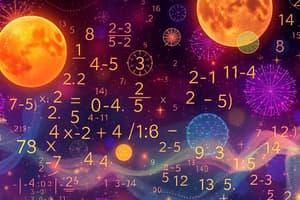Podcast
Questions and Answers
What is the correct way to simplify a fraction?
What is the correct way to simplify a fraction?
- Find the greatest common divisor of the numerator and denominator (correct)
- Multiply the numerator and the denominator separately
- Divide the numerator by the denominator
- Add the numerator and the denominator
How do you divide numbers in arithmetic?
How do you divide numbers in arithmetic?
- Multiply all numbers together
- Add the numbers together
- Subtract the divisor from the dividend
- Multiply the divisor by the quotient and subtract the product from the dividend (correct)
What is the result of multiplying 3 by 5?
What is the result of multiplying 3 by 5?
- 8
- 15 (correct)
- 12
- 20
In fractions, what does the numerator represent?
In fractions, what does the numerator represent?
How should you simplify a fraction when faced with reducing it?
How should you simplify a fraction when faced with reducing it?
What is involved in adding fractions?
What is involved in adding fractions?
How should addition and subtraction of decimals be performed?
How should addition and subtraction of decimals be performed?
What is the correct way to convert a percentage to a decimal?
What is the correct way to convert a percentage to a decimal?
What happens when converting a decimal to a percentage?
What happens when converting a decimal to a percentage?
In basic geometry, how are lines defined?
In basic geometry, how are lines defined?
What is the sum of interior angles in a triangle?
What is the sum of interior angles in a triangle?
How many sides does a circle have?
How many sides does a circle have?
Flashcards are hidden until you start studying
Study Notes
Math Basics: A Comprehensive Overview
Math basics set the foundation for understanding and applying mathematical concepts in our everyday lives. In this article, we'll dive into five fundamental subtopics: fractions, arithmetic, decimals, percentages, and basic geometry, providing you with the tools to build your mathematical skills.
Fractions
Fractions represent parts of a whole. They are expressed as a numerator (top number) over a denominator (bottom number). For instance, ( \frac{1}{2} ) represents half of the whole. To simplify a fraction, you can find the greatest common divisor (GCD) of the numerator and denominator and reduce the fraction.
- Addition and subtraction: Add or subtract the numerators while keeping the same denominator.
- Multiplication: Multiply the numerators and the denominators separately.
- Division: Invert the second fraction and multiply it by the first fraction.
Arithmetic
Arithmetic deals with the basic operations of addition, subtraction, multiplication, and division.
- Addition and subtraction: Perform the operations by lining up the numbers in columns, starting from the ones' place, and carrying over when necessary.
- Multiplication: Multiply numbers by multiplying digits in corresponding columns. For example, ( 3 \times 5 = 15 ).
- Division: Divide numbers by multiplying the divisor by the quotient and subtracting the product from the dividend. For example, ( 15 \div 5 = 3 ).
Decimals
Decimals represent fractions with a whole number and at least one digit after the decimal point.
- Addition and subtraction: Align the decimal points and perform the operations on the whole numbers and tenths, hundredths, and so forth, as necessary.
- Multiplication: Multiply the numbers, and add zeros after the decimal point if needed.
- Division: Divide the dividend by the divisor, and move the decimal point in the quotient the same number of places as in the divisor.
Percentages
Percentages represent parts of a whole as a percentage.
- Converting percentages to decimal form: Divide the percentage by 100.
- Converting decimals to percentage form: Multiply the decimal by 100.
- Converting percentages to fractions: Divide the percentage by 100, and then express the result as a fraction.
Basic Geometry
Basic geometry involves shapes, their properties, and relationships.
- Points, lines, and planes: Points are locations in a geometric space. Lines are extended one-dimensional figures formed by points. Planes are extended two-dimensional figures formed by lines.
- Lines and angles: Lines that intersect at a point form angles. Angles are measured in degrees.
- Triangles: Triangles have three sides and three interior angles that add up to 180 degrees.
- Circles: Circles are two-dimensional shapes containing points equidistant from its center.
This brief introduction to math basics will give you the tools to tackle more complex mathematical concepts in the future. Practice and patience are essential as you build your mathematical understanding and skills. Good luck!
Studying That Suits You
Use AI to generate personalized quizzes and flashcards to suit your learning preferences.




